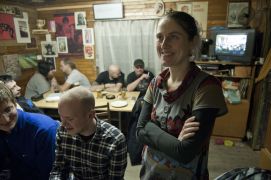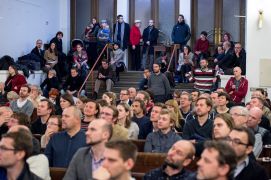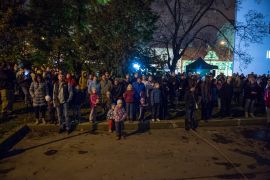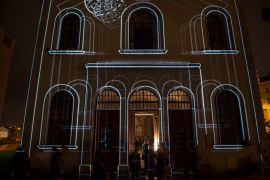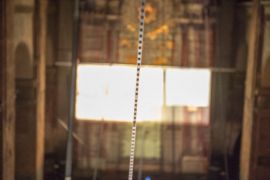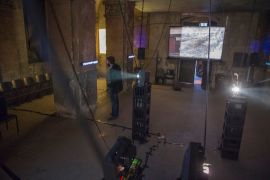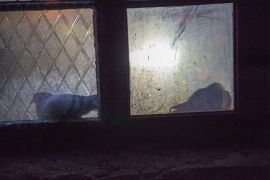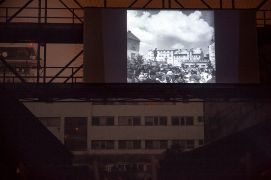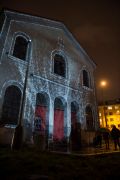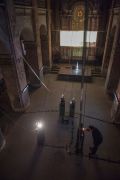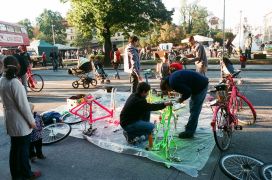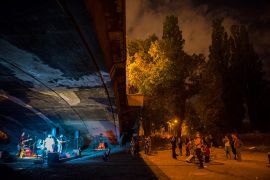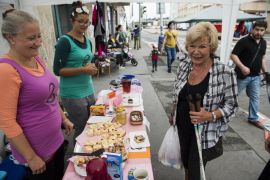Apparently, things started off dismal and grey. The main motives for the 8jinak! association came about from the controversial construction of a new town hall at Palmovka, the fates of the constructivist monument Palác Svět and the Libeň bridge, and the overall urbanist development planning in Prague’s 8th District. But the association eventually started enjoying the work they were doing on behalf of the neighborhood. They have organized exhibitions, screenings, workshops and open-air concerts for their fellow citizens, and have also developed an experimental film program that is community-oriented and locally inspired. By collecting and digitalizing historical analog films, they are working towards preserving the visual memory of Prague 8. In this interview, we speak with Pavlína Kalandrová, a member of the 8jinak! association.
Agosto Foundation (AF): The 8jinak! association was founded in 2011. What was the original motive for it?
Pavlína Kalandrová (PK): The first impulse for its founding was the largely definitive project for building the new townhall, which was being planned at the time. This was the Centrum Palmovka which was supposed to partly be the new townhall for Prague 8, and partly a shopping center. That is why, among others, me and my husband David Kumermann joined the association. It was a topic which raised fears among the public and we had the impression that the construction is flawed for a number of reasons. As members of the association, we devoted the following few years to finding real facts to back up our apprehensions. We really liked this direction for the group’s activities – opening up civic administration to the people, entering into dialogue with citizens, providing information and activation of the public and trying to get them to sit on boards, pose questions to their political representatives, make themselves heard and get informed…
Questions about the Centrum Palmovka
AF: What were your apprehensions about the Centrum Palmovka?
PK: Firstly, the construction seemed over-priced to us – it was supposed to cost 1,2 billion CZK taken from the budget which the district received from privatizing apartments. The resources were certainly ample, but the way the municipality allocated them, despite the townhall ultimately never being built, was another, quite sad, chapter of the whole story. The new townhall, its design and construction, seemed to have been chosen in a non-transparent fashion. There was no transparent tender – it rather consisted in a so-called “competitive discussion,” one which selected an already agreed-upon architect and construction company, which were Mr. Josef Pleskot and Metrostav respectively. Metrostav was to not only build the structure but was also supposed to operate it for the next twenty years. The contract for the construction was settled within the span of a few days, just before the election period.
But the conception itself – that the townhall would get rid of the apartment fund backed by the ideological argument that the city district cannot be a good caretaker, and then saying that in order to be a good caretaker, it must invest its resources into the construction of a huge building where it would operate a supermarket – that was strongly against our convictions. And then the fact that the building would be a banal panel house.
Rather than building an exemplary structure which would really make the city, the municipality cleared the way for other developers who would think that if this is possible, then they can also build huge solitary blocks without regard for the surrounding neighborhood. We repeatedly asked for information. The office sometimes provided us with it, sometimes they rejected our appeals, but the stock company Centrum Palmovka, although they were owned by the city district, legally did not have to provide us anything. We posted the outcomes and bulletins about the facts we found and had proof of on our website. With the assistance of the Via Foundation, we at one point printed out all the information and disseminated them in a flyer campaign. It was citizen activism.
AF: What is the story with the Centrum Palmovka now?
PK: As far as we know, the project has reached a dead end. There is no-one who would finish the construction. Prague 8 has started taking care of the incomplete building. Now the “new” leadership is discussing what to do with it and are even considering selling it off. From our perspective, it is good that the opposition to the leading party have voiced their reservations about the over-priced contract and wanted to settle with Metrostav, but ultimately this course of action led to a situation which no one is happy about.
Being active in the community
AF: Let’s move onto your next sphere of interest, which is culture. What is your role in the association?
PK: My profession indeed lies in the sphere of culture – apart from film production, I am also involved in both film and theater, although I am currently on maternity leave. I became a member of the association in 2011. The first thing I did with 8jinak! was the pre-Christmas event in front of the Komerční banka at Palmovka. It was a small series of short concerts, interventions and readings. The intention was to liven up the space which shows great potential for becoming a square but does not function that way.
In my profession, I am active in the sphere of culture which I would call alternative. It’s not focused on profit, but on quality. Here I mean not only the quality of the topic or its performance, but also the emphasis on experimentation – a culture which is oriented towards searching, not on established processes. As producer, I worked on creative documentary films, or was also producer at the Archa theater. That’s just a sample of what I find important.
And the same applies to what I do here, volunteering at Prague 8. To list some examples, I like to remember the projects Lieben Libeň and Hackenschmied 110 which were two events which followed three years after one another and which were quite similar – they both related to Libeň and to the Palmovka synagogue. They always focused on a given theme and aimed to rejuvenate the public space, specifically that of the synagogue and its surroundings, and served as a reminder of the place’s past. We always adopted an experimental approach to film and photography. In two cases, it was organized with the financial support of the city of Prague and Prague 8.
I still have a good feeling about it because the events combined my interest in culture and art with great public interest and footfall. It was always about connecting various types of art, film and video, working with film material, and so on. By the way, we are still collecting old 8mm and 16mm films which captured the neighborhoods of Prague 8, which we then digitize and occasionally screen during some event, usually once or twice a year.
AF: Is this a direction you would like to explore in the future?
PK: For a long time, the association has been working in a way that whenever anyone is interested or inspired by something and the others agree and it is not against our principles, preferences or constitution, we can realize whichever project they might want. It can be oriented towards art, urbanism or politics, and the others can help according to their ability, time, preferences and skills. They can help with the promotion or organization, for instance. As per the direction of our activities, I really like photographic or film projects.
For this year we intend to use the Perpedes grant from the Agosto Foundation and work in collaboration with the association Krajina Přílivu to prepare something experimentally filmic or something making use of light for the Palmovka synagogue and its surroundings. We will also organize discussions and panels with artists. The first one took place on January 10, 2020 with Jiří Černický, an artist who is also resident of Libeň. It related to it in some way, but not exclusively. This is more the initiative of art historian Terezie Nekvindová, and I am helping with the production and promotion. Apart from its focus on the area of Libeň, the topics are broader and I think they should be interesting for people from all around Prague. There will be about four meetings a year. The nearest one is in the middle of March with Tobiáš Jirous and Matěj Lipavský. We have been organizing them in collaboration with the Světova 1 gallery, which usually features student art.
AF: The 8jinak! association has organized many activities which relate not only to the Centrum Palmovka, but also Palác Svět, Libeň bridge, the city plan for Prague 8, as well as the city’s cultural rejuvenation. What are the current relationships between your association and the Prague 8 municipal board? Do you feel they have developed somewhat? Is your civic initiative welcome, or rather tolerated?
PK: Throughout the years, it has been difficult, and I think it’s the third election term now. Whether the municipality speaks to us or not is rather based on what we are focusing on at the moment and who is sitting on the board at the time. Of course, this was first the case with Centrum Palmovka. In their first term they either ignored us, for example refusing to come to a public debate although they were invited, or they hated us. When we asked the district deputies for some cooperation, or when we requested to have the rent waived for Elsnicovo square as part of the Zažít Libeň Jinak, it was a surprise for them that members of the 8jinak! association even dare to approach them when they want to organize something. It was met with a mix of ignorance and outright hostility which only confirmed that we had touched a sore spot.
Then the situation changed. The opposition took the reins. It was ČSSD, the Green Party and ANO as the strongest party. Thanks to the priorities of the Green Party, Prague 8 implemented, unfortunately only for a short time, the Local Agenda 21 . Since our foundation, our constitution stipulated that we support the implementation of this strategy for sustainable development at the local level. Mrs. Iva Hájková, who implemented the agenda at various other places, included us in her research relating to who is at various levels the most active in the district, and we were invited on the committee dealing with this agenda. They welcomed us, because they did not harbor any ill-feeling towards us, and our activities fit the municipality’s plans at the time.
Nowadays, we have the fall elections behind us, and ODS, Patrioti and TOP 09 have been voted in and the Local Agenda 21 is finished. On the other hand, we are generally a bit less active because we have been devoting more time to family and our children, our attention has shifted from the public space to our own home – whether this is temporary or only for a short spell I don’t know. But we still sustainably organize cultural events. What I find good is that the municipality is still in contact with us and we have the option to at least get information on urbanist development in Palmovka and the lower Libeň area, which was our initiative from 2013-2014. With the aid of the Via foundation we created the participative project Palmovka Jinak, whose aim was to organize an open call for an idea-focused urbanist competition. The outcome was supposed to be the creation of a binding urbanist plan for the further development of Palmovka. We approached both the public and politicians, had meetings and identified problems and the expectations for lower Libeň, Palmovka and their surroundings.
It was great that later ANO, ČSSD and the Green Party included it in their coalition contract. It was supposed to be organized by the deputy for strategic development, Mr. Petr Vilgus, who was also responsible for the Local Agenda 21. In fact, he started working on it only in the second half of his mandate and not much got done. It was good that they employed the studio Unit architekti to participate with the public. I think that they did a good job, but it was just too late, or the municipality was not ambitious enough, or unable. Our vision that they would influence developer projects around Palmovka did not come to pass. The urbanist competition was never launched, and they only make cosmetic changes as part of the Palmovka Teď! Event. But we are glad even for that. We were afraid that it would get lost with the new leadership.
On the one hand, we are glad that the collaboration with Unit architekti is continuing and the little propositions are starting to get implemented. For example, the tram stop Na Žertvách received a new mobiliary and was re-paved and new changes are being prepared. On the other hand, the plan for the area will be made, but not in the form of a tender – it was given to Unit architekti. It makes sense, because they know the most about the issue, but the fact that there will be no tender is still serious.
AF: After your years of trying to influence the development of Palmovka and its surroundings, have you not wished to enter politics and have larger say in the decisions taken by the municipality? For example, similar civic activities have gotten leading positions in the districts of Prague 7 or Prague 10.
PK: We of course follow these developments – the association Letná / Praha Sobě, or the Vlasta group, we root for them. But we prefer to keep the association independent of political parties. Věra Chmelárová was for example offered a candidature, but she refused. It is on the table, as these things tend to meld. Personally, I would not do it. It is difficult in that the district is so large and diverse, it’s huge – it’s basically the size of a regional city like Olomouc and has some one hundred thousand inhabitants.
AF: Based on the results you get and the long-term experience you have with it, does civic initiative stand a chance? You were originally systematically focused on urbanism, visiting meetings and critiquing the municipality’s decisions; you requested information, asked questions, and were expertly informed in the field through your collaboration with architects and urbanists.
PK: Many changes have been happening in Libeň only with the massive residential development, with projects by Metrostav and Crestyl on Libeň island, just between Palmovka and Libeň bridge. It is fascinating to see how much energy we dedicate to activities which somehow rejuvenate the space, like Zažít Elsnicovo Náměstí Jinak, Zažít Libeňský Most Jinak or Na Žertvách. But people come and go. It was illustrative at the Palmovka synagogue where we wanted to not only rejuvenate the surrounding space, but also cultivate it by adding outside seating, an improvised café and workshops, cutting the bushes which had been serving as toilets. People could come with their children, and not have to be afraid to set foot on the grass. It cost us a lot of energy.
Something was retained to stay there, but I want to say that real change can only come with real “hardware”, I mean the very structure of design, of what stands there and where the barriers are set up. Even the fact that we are sitting in a café in Světova St. is unfortunately not our doing, as it was not us who rejuvenated the area, but rather the fact that dozens of new apartments were built here and hundreds of square meters of office space, which also changed the constitution of the locals. It brought more people along with it, including people who have more money, for instance. The chance which, I think, Prague 8 missed out on was to allow people to have more say in these projects and influence it for the benefit of the people. They’re not always exactly bad, for example the project in Libeň docks will have public space and access to water, which is lacking here.
But I still think that a person has the option, and also the responsibility, to influence things, of course as far as his or her strength and will allow. This is about sustainable personal lives – you can’t force yourself to take interest in these things. You can devote some time to it, until you can’t and it is time to take a break from it. But of course, this is also our responsibility as the public. I believe in civic society and in its ability to change things. Our results are softer in the community; maybe it’s the people’s conviction that living here makes sense, that it’s in fact nice, despite there being certain issues …
AF: You mentioned the sustainability of this activity. What direction will the association’s activities take in this sense?
PK: The objective is to foster and support the community. Or at least build a place for life and to create a space for others in the process. For me, a big theme after all these years, and even in my new situation of becoming a mother, is the topic of sustainability. Generally, protecting public interest is the job of the municipal government, it has the power and mandate to do it. What should last for long years and run parallel to the election results and the current government is the civic society and its associations. These should not be regarded as enemies to the municipality, but should rather be taken into account, supported and listened to. The Local Agenda 21 was a good tool for that, and it is a shame that it is no longer active.
Interview by Radoslava Schmelzová.
